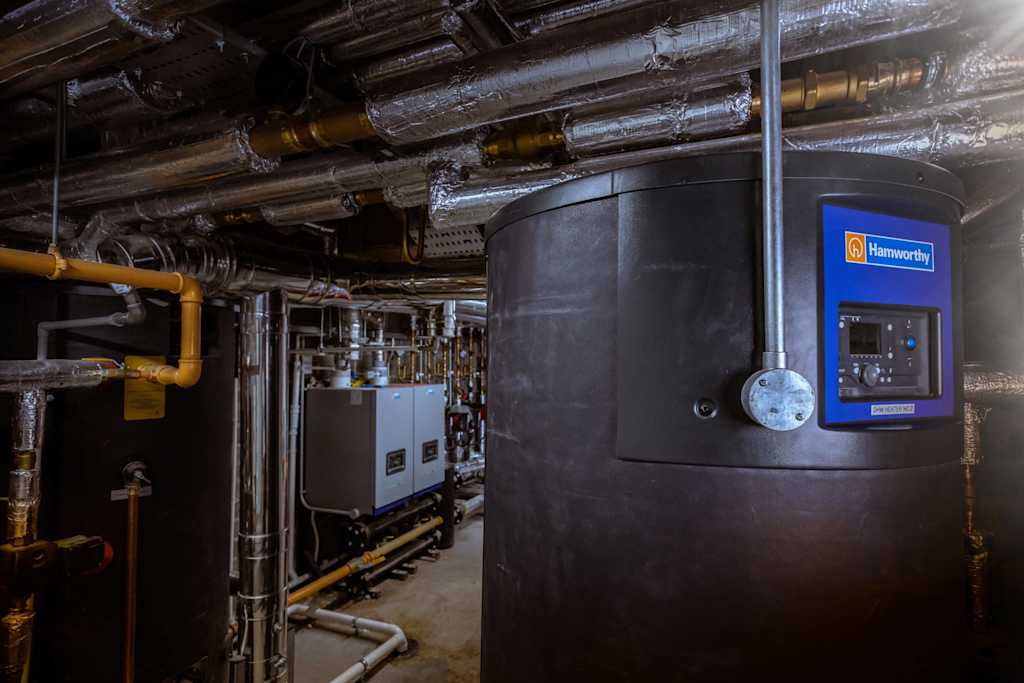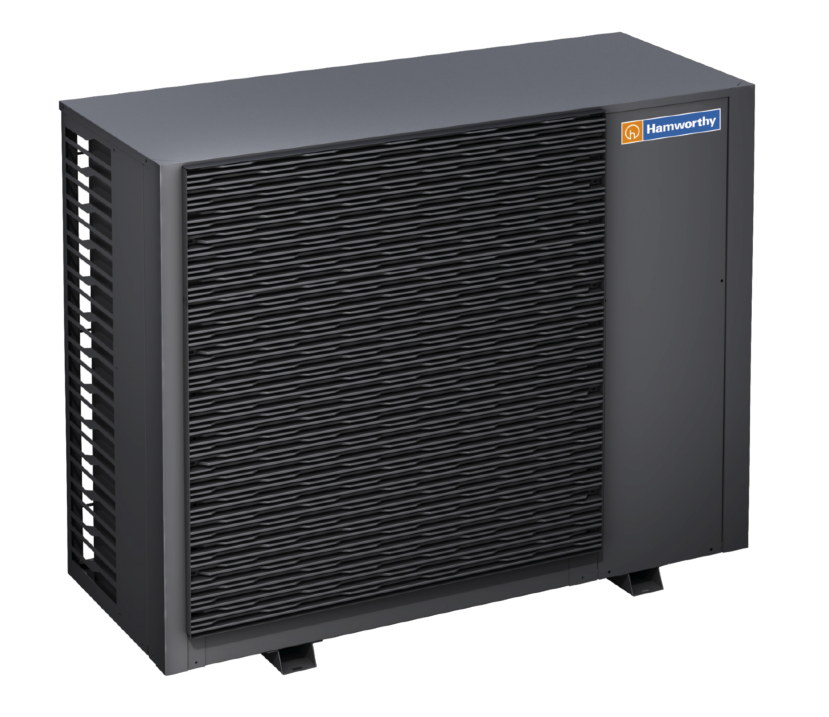Key considerations when selecting a hot water system for your next commercial project

Selecting the right hot water system is essential to achieve optimum performance and efficiency in any commercial project. To make the best choice, it’s important to evaluate key factors such as energy efficiency, system demands and size, installation requirements, and long-term maintenance. With this in mind, Hamworthy Heating provides expert guidance on how to choose a reliable, efficient, and sustainable hot water solution tailored to the specific needs of different commercial environments.
Upgrading to an energy efficient solution
In line with the 2021 update to Part L regulations, installing a non-condensing water heater is no longer permitted, unless the site is exempt. Additionally, many non-condensing systems are reaching the end of their lifespan, making it an ideal time to consider upgrading to a condensing model, such as the Dorchester DR-SG stainless steel condensing water heater, which captures latent heat from flue gases to increase product efficiency.
However, before making this transition, it’s essential to carefully consider several key factors when selecting a commercial hot water system to ensure it meets the building��’s specific requirements. Given the peak and continuous hot water demands of most commercial properties, choosing a system that minimises energy consumption while offering reliability and durability is key. Here, opting for energy efficient models can significantly reduce long-term operational costs and support a more sustainable business.
Hot water demands, sizing & recovery rates
Another important consideration is the size and capacity of the hot water system. Commercial spaces vary in terms of their hot water demands, depending on the number of occupants or usage points, so choosing a system with the right capacity will ensure that hot water is readily available as and when needed, without overloading the system. Most importantly, an adequately sized water heater can help to avoid unnecessary energy waste and unnecessarily high energy costs for the customer.
To achieve an appropriately sized system that best meets the needs of a building, the best starting point is to gather detailed information about the specific building and its usage. For new builds, understanding the client’s requirements is vital to ensure that all factors, such as the quality and location of DHW outlets, the intended usage, and the number of users, are accounted for. Furthermore, anticipating any challenges and identifying potential issues early on can save time and effort later on in the process.
In the case of refurbishment projects, conducting a thorough site survey is just as important. It can uncover issues with the current hot water system, such as non-compliance or inefficiencies, and highlight opportunities for more suitable solutions. Additionally, it’s important to consider that building usage patterns may have changed since the original system was installed. For example, an increase in occupancy or the installation of additional sanitary outlets could mean that the current system is either over or undersized, necessitating an upgrade to meet current demands.
This process is also the perfect time to understand a building’s demands, for instance, in situations where hot water demand peaks in a short period, such as during morning showers in a hotel, storage capacity will be a key consideration. However, in applications with more consistent demand, where storage is less of a concern, recovery rate will be the primary factor.
Equally, for buildings with varying hot water demands throughout the day, both storage and recovery will need to be carefully balanced. In these cases, the system should be sized based on the hourly demand, factoring in simultaneous usage. However, it is also important to plan for future growth, for instance, a building may not be operating at full capacity from the offset so it’s important to specify a hot water system that can accommodate any expected increases in demand.
Footprint & installation requirements
Product dimensions may also play a significant role in product selection. Plant rooms come in all different shapes and sizes, so it’s important to ensure the chosen system fits within the available space, and allows clearance for adequate ventilation, and future maintenance access.
For plant rooms with limited space, such as those within city centres, or where maximising existing space is a priority, compact and lightweight designs offer increased flexibility. Also, as traditional water heating systems can be bulky and heavy, it’s important to carefully review product specifications. For example, the Dorchester DR-SG stainless steel condensing water heater from Hamworthy Heating features a narrow diameter of less than 80 cm, making it specifically designed to fit through a standard 800 mm doorway. Its lightweight and slim design not only facilitates easy transport and installation but also ensures that the system remains accessible for routine service and maintenance.
“The small footprint of the DR-SG provides customers with a flexible solution when working in tight plantrooms. Also, there’s the added benefit of being able to remove the installation jacket, if needed. We’ve found that this is a particularly important consideration for customers who need to access tight city centre plantrooms”, says Kevin Potter, Hamworthy's National Sales Manager.
The benefits of stainless steel explained
When it comes to water heaters, corrosion is the enemy. Unlike enamelled or glass-lined steel products, which require additional measures to minimise the risk of corrosion, water heaters equipped with stainless steel technology – such as the Dorchester DR-SG – feature high-grade stainless steel combined with electrical anode protection. This advanced design provides a robust defence against corrosion, significantly enhancing the durability of the system and contributing to an extended lifespan.
The Dorchester DR-SG, which is available in ten power outputs over three storage capacities, features a durable stainless-steel tank, heat exchanger and coil for enhanced performance, efficiency, and increased service life.
From a practical perspective, stainless steel products, such as the Dorchester DR-SG also have the added advantage of being lighter in weight, which makes them easier to transport, handle, and install, often without the need for expensive cranes or heavy lifting equipment, which can quickly see installation costs escalate.
Additionally, for that added peace of mind, most manufacturers typically back stainless steel water heater systems with strong warranty coverage, reflecting confidence in the product’s longevity and reliability.
Determining water composition
When choosing a water heater, it’s also important to consider water composition. This is important as different water types can affect the heater’s performance, efficiency, and lifespan. Hard water, containing minerals like calcium and magnesium, can lead to scale buildup in water heaters, which acts as an insulator, reducing heat transfer and increasing energy consumption. Over time, this can cause wear on the system and eventually lead to failure. To address this, water heaters designed to handle hard water, such as those with stainless steel tanks, are a good choice.
In comparison, in areas with soft water, the absence of minerals means there’s no scale buildup; however, the water is more corrosive. This can cause metals to corrode more quickly, degrading the internal components of the water heater and affecting its performance. To prevent this, materials resistant to corrosion, like high-grade stainless steel, are ideal.
Ultimately, selecting the right water heater involves understanding the local water quality and the specific requirements of the building. Choosing a system designed to handle these challenges ensures optimal performance, increased energy efficiency, and a longer lifespan. Many systems, like the Dorchester DR-SG, offer a versatile and robust solution that can perform effectively in a range of water conditions.
Conclusion
Selecting an efficient and durable hot water system is a crucial decision for any commercial project, and it requires a detailed assessment of various key factors. These include energy efficiency, system size, installation requirements, water composition, and long-term maintenance needs. By carefully considering these elements, you can ensure the system will meet the specific demands of the building, provide reliable performance, and reduce long-term operational costs.
Furthermore, with heating (including hot water generation) accounting for approximately 23% of total carbon emissions in the UK, it is more important than ever to prioritise energy-efficient and condensing heating solutions.









